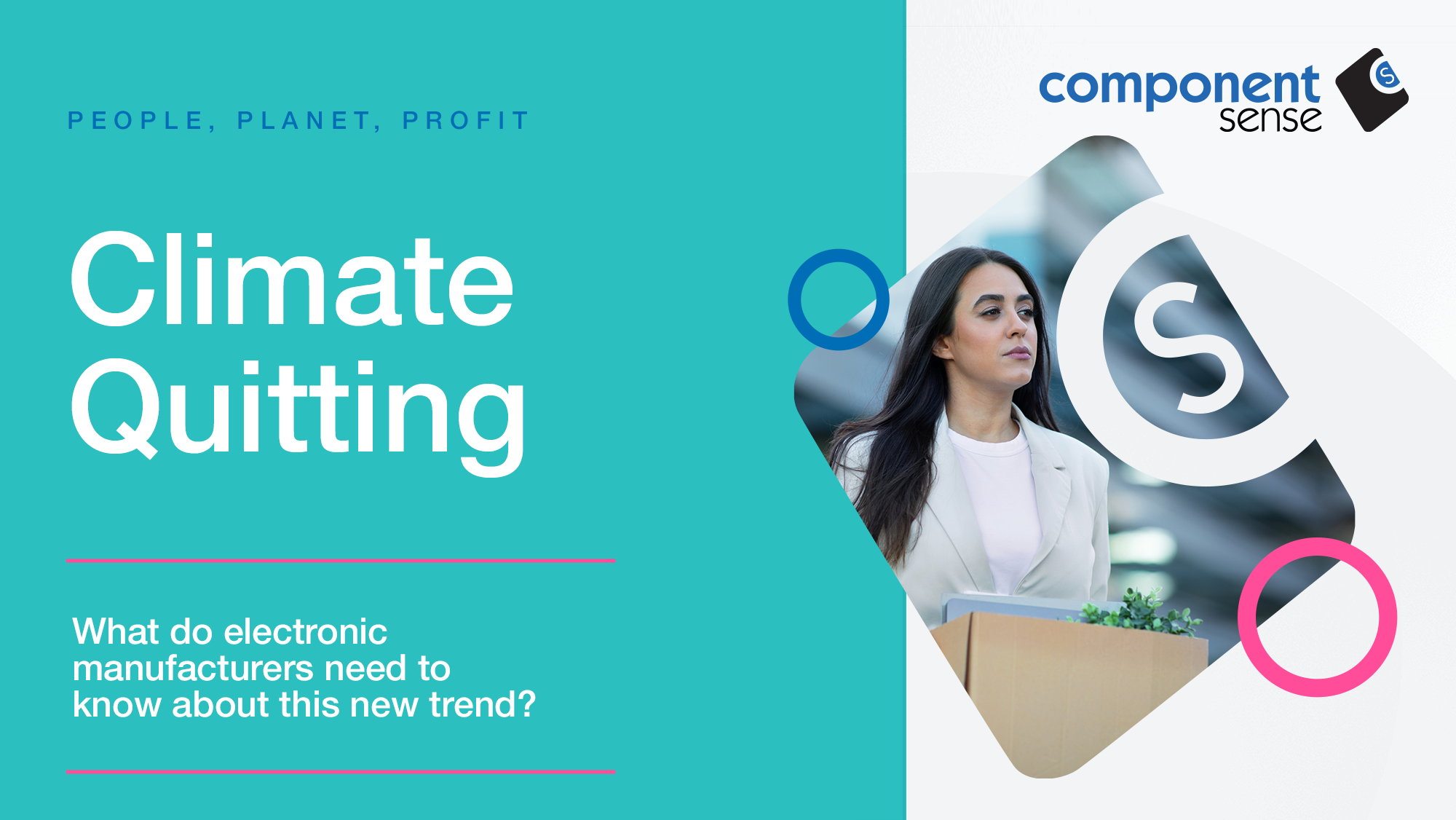How To Prepare Your Business For Climate Quitting

You may have heard of quiet quitting, but what about climate quitting?
If this phrase is new to your vocabulary, you are not alone. Climate quitting was only coined about a year ago and gained popularity after COP28. This new movement should be on the radar of electronic manufacturers that want to attract and keep top talent.
Climate quitting is a growing trend among people, especially Gen Z, who are resigning from roles to go after jobs at companies prioritising environmental sustainability. Paul Polman surveyed 4000 UK and US employees and found that 45% of respondents would consider quitting if their firm’s values did not align with theirs. 35% said they had already resigned for this very reason.
So, what can your business do to avoid losing top talent?
1. Understand ESG

When preventing climate quitting, the best place to start is understanding ESG. This handy acronym stands for three pillars:
- Environmental: This encompasses a company’s practices regarding waste, pollution, emissions, and use of resources. For example, a company may have policies to ensure the recycling of materials.
- Social: Specific business areas covered by this pillar include diversity in the workplace, health and safety, community engagement, and general employee relations. For example, a company may report on health and safety standards throughout its supply chain.
- Governance: Executive remuneration, political lobbying, board structure, and tax strategy are all focus areas under governance. For example, a company may promise to flush out corruption and anti-competitive behaviour.
Research by KPMG that quizzed 6000 new workers who had left higher education in the past six months found that 30% of people researched a company’s ESG credentials when job hunting. Electronic manufacturers must, therefore, report on current ESG practices and set a programme to improve problem areas if they want to attract fresh, talented employees.
2. Offset carbon emissions

The leading cause of global warming is the release of greenhouse gases like carbon dioxide. So, you can understand why the amount of carbon a business emits can be a deciding factor for climate quitters. Firstly, electronic manufacturers would be wise to reduce carbon emissions as much as possible throughout their supply chain. Secondly, offsetting what they do pump into our atmosphere is a smart idea.
There are plenty of carbon offsetting schemes in the market. These programs may offset carbon emissions using methods including:
- Planting trees
- Investing in clean energy technologies
- Capturing methane gas at landfills
At Component Sense, we work with One Tree Planted to plant not one but two trees per order. We highly recommend this company if you are researching the best option for offsetting efforts.
3. Explore environmental certifications
 Environmental certifications are one way to demonstrate to employees that you mean business regarding sustainability. Many certifications are available to electronic manufacturers. However, it is vital to invest in initiatives that are relevant to your specific industry.
Environmental certifications are one way to demonstrate to employees that you mean business regarding sustainability. Many certifications are available to electronic manufacturers. However, it is vital to invest in initiatives that are relevant to your specific industry.
Generally, applying for an environmental certification involves proving compliance with set criteria related to climate practices, presenting data to substantiate your claims, and investing capital to pay for the title. Some popular environmental certifications that are highly relevant for electronic manufacturers include:
- B Corp
- ENERGY STAR
- Green Product Certification
- Chartered Sustainable Supply Chain and Logistics Professional (CSSCLP™)
At Component Sense, we believe prioritising the environment has financial benefits and helps prevent climate quitting. Our business is very close to reaching net zero, and we plan to be officially planet-positive by 2025. Reaching milestones like this sends a positive message to both employees and customers.
4. Reduce e-waste

59.5 million metric tons of e-waste. That is how much the global electronics industry produced in 2022 alone. It was visiting factories and viewing the high level of excess and obsolete (E&O) component stock that started Component Sense’s journey in the first place. For top electronics industry talent, how a company deals with e-waste could also be the deciding factor when choosing a new job.
Component Sense makes it easy for electronic manufacturers to reduce their e-waste, which often contains toxic materials like lead and mercury. By redistributing your E&O stock to be used by other manufacturers, you are promoting a circular economy. Not to mention, redistributing your E&O stock generates effortless supplemental cash flow.
5. Engage with your employees

Communication is critical for a positive climate mindset. Engaging with your staff openly and honestly ensures that your employees understand that the business prioritises sustainability. Many people value seeing a robust business plan, and connecting with your mission is one way to ensure they are invested and find meaning in their work. Inviting employees to participate in developing your sustainability program of ESG work is another fantastic way to get buy-in.
An essential part of communicating your commitment to sustainability and minimising climate change is officially reporting on your ESG goals and progress. There is no standardised ESG framework. However, more and more companies are reporting on their efforts to employees, customers, and investors. Two common forms of ESG reporting include:
Make positive changes to your supply chain with Component Sense
Electronic manufacturers should not fear climate quitting if they are open, transparent, and environmentally friendly. One giant leap your business can take in sending the right signals to your employees is redistributing your E&O component stock that would otherwise be sent to landfills. You can read more about the global complexity of electronic waste or email us for further information about our excess stock solutions.